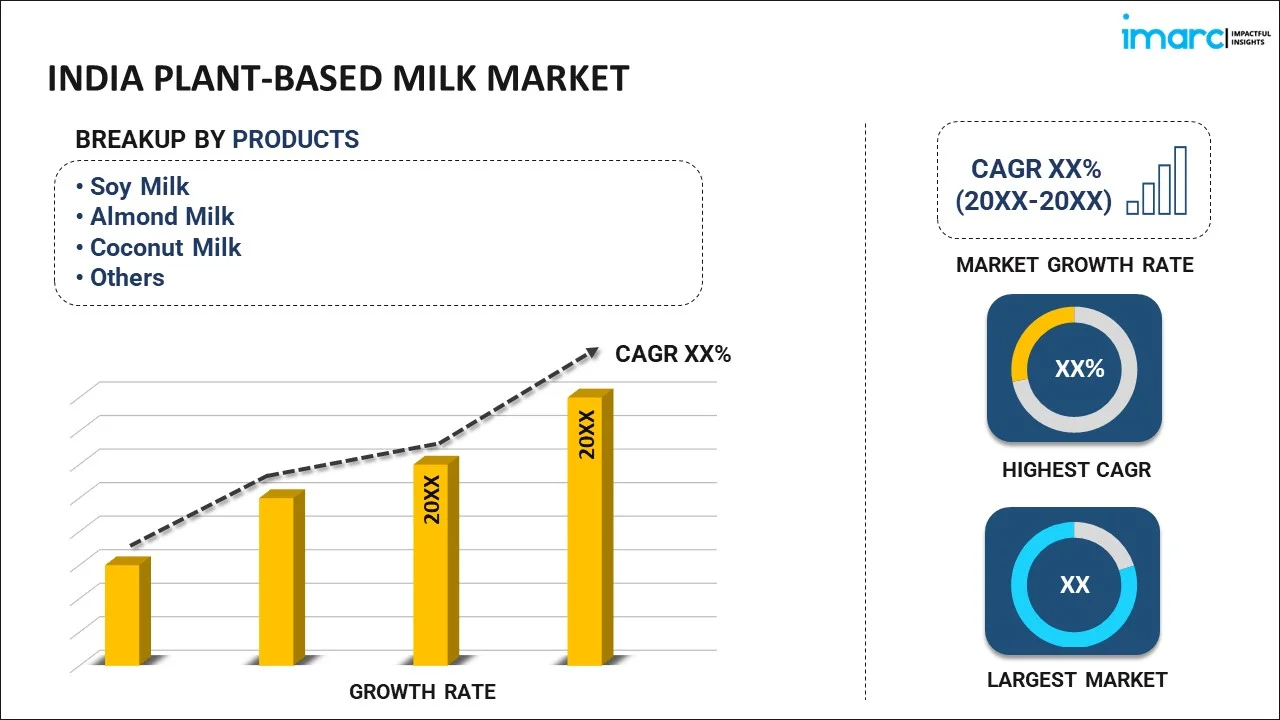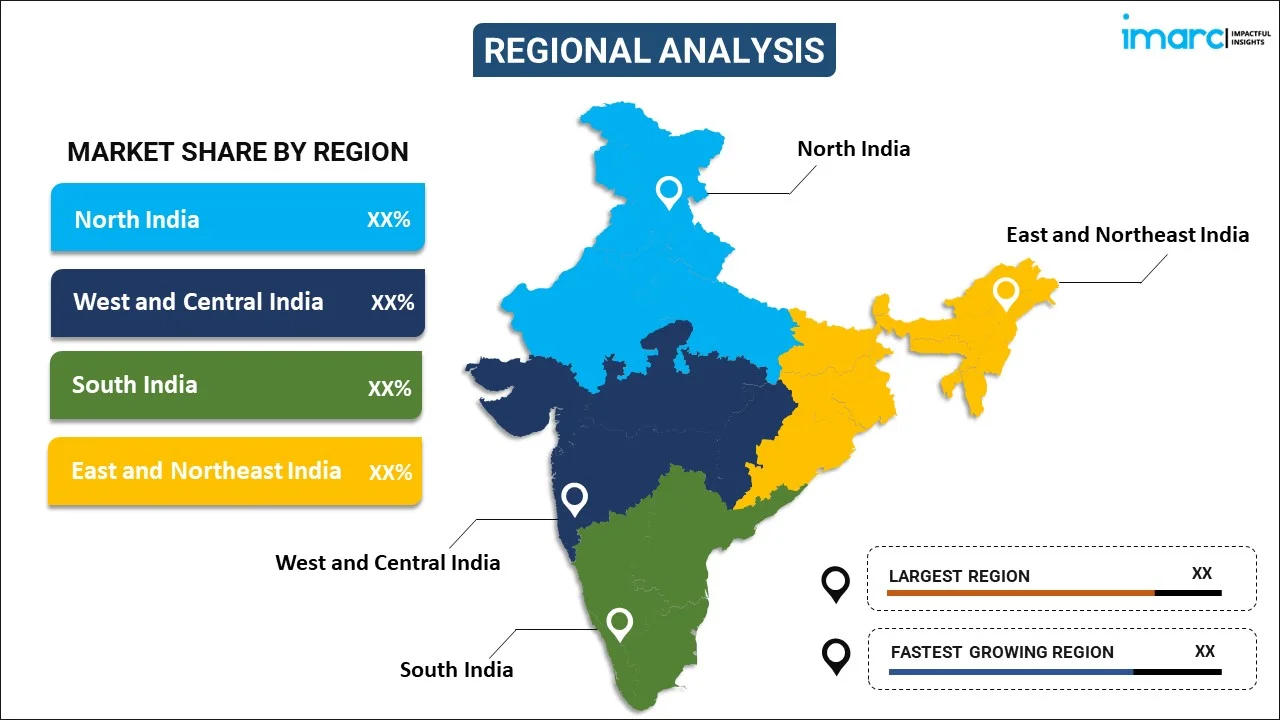
India Plant-Based Milk Market Report by Product (Soy Milk, Almond Milk, Coconut Milk, Rice Milk, Oat Milk, and Others), Formulation (Unflavored, Flavored), Category (Organic, Conventional), Form (Liquid, Powder), Distribution Channel (Business-to-Business, Business-to-Consumer), and Region 2025-2033
Market Overview:
India plant-based milk market size reached INR 2.97 Billion in 2024. Looking forward, IMARC Group expects the market to reach INR 11.83 Billion by 2033, exhibiting a growth rate (CAGR) of 16.40% during 2025-2033. The ongoing advancements in plant-based food technology, leading to improved taste, texture, and nutritional profiles of plant-based milk, are driving the market.
|
Report Attribute
|
Key Statistics
|
|---|---|
|
Base Year
|
2024 |
|
Forecast Years
|
2025-2033 |
|
Historical Years
|
2019-2024
|
| Market Size in 2024 | INR 2.97 Billion |
| Market Forecast in 2033 | INR 11.83 Billion |
| Market Growth Rate (2025-2033) | 16.40% |
Plant-based milk refers to non-dairy alternatives created from plants, offering a lactose-free and vegan-friendly option to traditional animal milk. Common sources include soy, almond, coconut, oats, and rice. These alternatives are often fortified with essential nutrients like calcium and vitamin D to mimic the nutritional profile of cow's milk. Plant-based milk has gained popularity due to various reasons, including lactose intolerance, ethical concerns, and environmental sustainability. These alternatives often have a distinct flavor and texture, providing a diverse range of options for consumers with different taste preferences. Plant-based milk is not only a choice for those following a vegan lifestyle but also appeals to individuals seeking a more sustainable and cruelty-free approach to their dietary habits. As the demand for plant-based options continues to rise, the market for these alternatives expands, offering consumers a broader selection of plant-derived milk products.
India Plant-Based Milk Market Trends:
The plant-based milk market in India is experiencing robust growth, primarily driven by the increasing regional awareness of health and environmental concerns. Consumers are increasingly opting for plant-based alternatives, a trend underscored by a growing preference for dairy-free options. Furthermore, the surge in lactose intolerance cases and the rising number of individuals adopting vegan lifestyles contribute significantly to the market's expansion. In addition to health considerations, sustainability plays a pivotal role in propelling the plant-based milk market forward. Concerns about climate change and the environmental impact of traditional dairy farming have led consumers to seek more sustainable choices. As a result, plant-based milk options are perceived as environmentally friendly alternatives, fostering their widespread adoption. The diversification of plant-based milk varieties also fuels market growth. Innovations in plant-based technologies have given rise to a plethora of alternatives, such as almonds, soy, oats, and coconut milk, catering to diverse consumer preferences. These options provide not only choice but also nutritional benefits, addressing specific dietary needs and preferences. Consequently, the dynamic interplay of health consciousness, sustainability, and product innovation serves as a powerful force driving the flourishing plant-based milk market.
India Plant-Based Milk Market Segmentation:
IMARC Group provides an analysis of the key trends in each segment of the market, along with forecasts at the country level for 2025-2033. Our report has categorized the market based on product, formulation, category, form, and distribution channel.
Product Insights:

- Soy Milk
- Almond Milk
- Coconut Milk
- Rice Milk
- Oat Milk
- Others
The report has provided a detailed breakup and analysis of the market based on the product. This includes soy milk, almond milk, coconut milk, rice milk, oat milk, and others.
Formulation Insights:
- Unflavored
- Flavored
A detailed breakup and analysis of the market based on the formulation have also been provided in the report. This includes unflavored and flavored.
Category Insights:
- Organic
- Conventional
The report has provided a detailed breakup and analysis of the market based on the category. This includes organic and conventional.
Form Insights:
- Liquid
- Powder
A detailed breakup and analysis of the market based on the form have also been provided in the report. This includes liquid and powder.
Distribution Channel Insights:
- Business-to-Business
- Business-to-Consumer
- Modern Groceries
- Convenience Stores
- Specialty Stores
- Online Retail Stores
- Others
The report has provided a detailed breakup and analysis of the market based on the distribution channel. This includes business-to-business and business-to-consumer (modern groceries, convenience stores, specialty stores, online retail stores, and others).
Regional Insights:

- North India
- West and Central India
- South India
- East and Northeast India
The report has also provided a comprehensive analysis of all the major regional markets, which include North India, West and Central India, South India, and East and Northeast India.
Competitive Landscape:
The market research report has also provided a comprehensive analysis of the competitive landscape. Competitive analysis such as market structure, key player positioning, top winning strategies, competitive dashboard, and company evaluation quadrant has been covered in the report. Also, detailed profiles of all major companies have been provided.
India Plant-Based Milk Market Report Coverage:
| Report Features | Details |
|---|---|
| Base Year of the Analysis | 2024 |
| Historical Period | 2019-2024 |
| Forecast Period | 2025-2033 |
| Units | INR Billion |
| Scope of the Report | Exploration of Historical Trends and Market Outlook, Industry Catalysts and Challenges, Segment-Wise Historical and Future Market Assessment:
|
| Products Covered | Soy Milk, Almond Milk, Coconut Milk, Rice Milk, Oat Milk, Others |
| Formulations Covered | Unflavored, Flavored |
| Categories Covered | Organic, Conventional |
| Forms Covered | Liquid, Powder |
| Distribution Channels Covered |
|
| Regions Covered | North India, West and Central India, South India, East and Northeast India |
| Customization Scope | 10% Free Customization |
| Report Price and Purchase Option | Single User License: US$ 2999 Five User License: US$ 3999 Corporate License: US$ 5499 |
| Post-Sale Analyst Support | 10-12 Weeks |
| Delivery Format | PDF and Excel through Email (We can also provide the editable version of the report in PPT/Word format on special request) |
Key Questions Answered in This Report:
- How has the India plant-based milk market performed so far and how will it perform in the coming years?
- What has been the impact of COVID-19 on the India plant-based milk market?
- What is the breakup of the India plant-based milk market on the basis of product?
- What is the breakup of the India plant-based milk market on the basis of formulation?
- What is the breakup of the India plant-based milk market on the basis of category?
- What is the breakup of the India plant-based milk market on the basis of form?
- What is the breakup of the India plant-based milk market on the basis of distribution channel?
- What are the various stages in the value chain of the India plant-based milk market?
- What are the key driving factors and challenges in the India plant-based milk?
- What is the structure of the India plant-based milk market and who are the key players?
- What is the degree of competition in the India plant-based milk market?
Key Benefits for Stakeholders:
- IMARC’s industry report offers a comprehensive quantitative analysis of various market segments, historical and current market trends, market forecasts, and dynamics of the India plant-based milk market from 2019-2033.
- The research report provides the latest information on the market drivers, challenges, and opportunities in the India plant-based milk market.
- Porter's five forces analysis assist stakeholders in assessing the impact of new entrants, competitive rivalry, supplier power, buyer power, and the threat of substitution. It helps stakeholders to analyze the level of competition within the India plant-based milk industry and its attractiveness.
- Competitive landscape allows stakeholders to understand their competitive environment and provides an insight into the current positions of key players in the market.
Need more help?
- Speak to our experienced analysts for insights on the current market scenarios.
- Include additional segments and countries to customize the report as per your requirement.
- Gain an unparalleled competitive advantage in your domain by understanding how to utilize the report and positively impacting your operations and revenue.
- For further assistance, please connect with our analysts.
 Inquire Before Buying
Inquire Before Buying
 Speak to an Analyst
Speak to an Analyst
 Request Brochure
Request Brochure
 Request Customization
Request Customization




.webp)




.webp)












